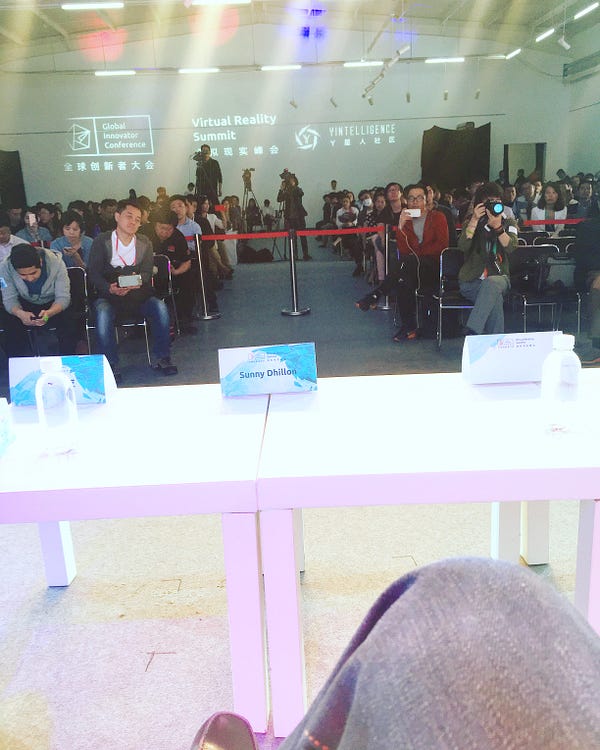Above video: My good friend, and frequent coinvestor, Tipatat Chennavasin, drew this Chinese dragon for this article in Tilt Brush. He’s wearing a Vive!
I was at SFO with some time to kill before a flight to Beijing last week, and picked up the latest issue of The Economist. I read doom and gloom for China. China is a $10 trillion dollar economy suffering through a plummeting stockmarket and a global commodity collapse. Total debt has gone from 150% of GDP before 2008’s financial crisis to 250% today. Capital outflows have surged, bankruptcies are occurring more frequently and bad loans in the banking sector are rising. Dire times like these are when it might be best to put on a VR headset, swim down the river with Baloo on a Jungle Book VR experience, and forget about your (economic) worries and your strife.

There is indeed a ray of light among this otherwise beleaguering malaise however — the explosive growth ahead for China’s fledgling VR industry! I was invited to speak at China’s Global Innovator Conference VR Summit for a few days and was very impressed with what I saw.
China has traditionally had a strong base of gamers and game developers, leading VR innovation in the People’s Republic. Chinese gaming companies,Tencent, OurPalm, LongTu, etc. are all interested to do more in VR, whether through internal R&D or investment in third party VR startups. Multibillion dollar Chinese tech companies, Baofeng and LeTV, both have mobile VR headsets of their own. China’s component manufacturers for smart phones, TV screens, and various smart sensors are a technical and manufacturing foundation from which to build VR headsets (even though most current incarnations are poor low-tech knock offs at present). While I lack data to support it, the past few days I’ve been told public Chinese gaming companies will trade at a premium on the stock market if they’re seen to have VR as a core focus area for the future. It’s a white hot space right now that has Chinese gaming companies making it rain renminbi.
Public Chinese gaming companies will trade at a premium on the Shenzhen Stock Exchange if they’re seen to have VR as a core focus area for the future.
I’ve met hundreds of Chinese entrepreneurs, investors, and government officials over the past few days. And I’ve counted over 40 different mobile VR HMD manufacturers (as many as 100 are mentioned here by a local Chinese VR news site). Most I’ve seen have been Google Cardboard rip offs — i.e. basic plastic phone holders with stereoscopic lenses. The conference I attended gave me such a headset with its logo painted on the side. I have about a dozen of these now (among them, one from the New York Times, another from Coca Cola). While last year’s Oculus Connect conference in LA had the company’s chief scientist, Michael Abrash, talking about hardware advancements to incorporate hearing and smell in VR, most Chinese companies I spoke with were unaware of any such advanced efforts in China. If I had to bet though, I would say China will move along the hardware learning curve very quickly and innovate in unison with the West Coast within the near future. If rumors are true, Chinese headset manufacturers are indeed already climbing this curve quickly, with several gaming companies working on all-in-one, untethered headsets (similar to the upcoming rumored version of Google’s new mobile VR headset, with head tracking and hand-based inputs included).

As part of my conference panel, Shanda President, Robert Chiu, and I spoke to a packed room of 1,000+ attendees about where we plan to invest. Most folks in attendance were either aspiring VR developers or investors from family offices, private equity funds, and from VC arms of strategic corporations. Shanda has made a dozen or so VR investments to date and was very vocal about its belief in arcade / theme park VR (i.e. The Void) experiences. I agreed with Robert that this will be a meaningful standalone market — in China and the US. But I also think it will have a wider impact; namely, a near term monetizable mass demo experience for evangelizing VR as a whole, paving the way for in-living room VR down the line. Particularly in China, it will allow the thousands of PC-ready internet cafes to rejuvenate their revenue streams as hardcore PC gaming growth slows. While living-room VR might be further away in China (for example, because of smaller city living and a relative lack of high end PC’s in the home), VR will be introduced to the Chinese masses through these arcade experiences, and then most likely through mobile VR headsets.
VR will be introduced to the Chinese masses through these arcade experiences, and then most likely through mobile VR headsets
Across 40 demo booths and 30+ conference talks, mention of augmented reality was noticeably missing. MagicLeap, Google’s Project Tango, and HoloLens were not discussed. What’s more, I don’t think Ready Player One’s Mandarin translation has been that widely read yet, so talk of The Oasissurprisingly fell on blank stares (…as this is considered the West’s VR Bible). Also absent were discussions around VR applications in the enterprise, healthcare, communications, or education.
In terms of investment dollars, I met several dedicated VR investors in Beijing and Shanghai and realized that Chinese VR investing needs to develop beyond the strategic gaming and electronics companies currently deploying capital. Experienced angel investors and incubators, VR-interested general partners at Chinese venture funds, and even limited partners with an appetite for risky VR investing (perhaps through VR sector focused funds) at this early stage, are all needed for Chinese VR to mature. Gaming companies seeking a public market trading multiple jump by chasing a hot space will NOT be helpful long term. The past 1.5 years since Oculus’ $2bn acquisition have sent expectations soaring far beyond reality throughout the VR investment world. China has not had its ‘Oculus moment’ yet. The space has not attained validation beyond gaming enthusiasts as a result — while Oculus was envisioned as a gaming device by Palmer Lucky at first, it soon evolved to become much more than that, kickstarting the last couple of years of breakneck innovation and investment in the West.
China has not had its ‘Oculus moment’ yet. The space has yet to attain validation beyond gaming enthusiasts
China will progress quickly, not only in hardware and fundraising, but in community as well. The country will see dedicated community-driven conferences that allow for diffusion of best practices and better networking of the country’s VR tinkerers and makers. It’s just a matter of time. In the States, a VR enthusiast can walk up to pretty much anybody at an UploadVR or VRLA event; no question is a dumb question. Everyone is approachable. More events like the VR Summit I just attended are needed in Beijing and Shanghai as the flood of interest continues to grow. On this front, there are some helpful resources for the Chinese VR developer community — the best I’ve heard about is Yivian, China’s equivalent of UploadVR (it’s in Mandarin, but occasional English language pieces can be found too).
Chinese VR will progress quickly, not only in hardware and fundraising, but in community as well
So where do we play into all of this? Well, Western HMD platforms should begin making bigger inroads in China later this year or early next. While the pre-existing Playstation 4 install base is far lower in China than the West, VR hardware dissemination is important to demo for the masses. Valve and Oculus should be sending developer kits to Beijing and Shanghai by the boatload. I mean, for Anorak’s sake, most of these headsets are manufactured in China as it is — just take some units off the assembly line for local use, guys! Both Oculus and HTC should seed the ecosystem with developer content cash and partner with cheap Chinese PC makers for local market price optimization. Oculus’ CTO, John Carmack, should at the very least be aware of China’s mobile VR headset advancements as he strives to focus on positional tracking for the Samsung/Oculus Gear VR device.
Expanding beyond gaming applications for VR — i.e. for sports, film/TV, music, and enterprise VR applications — was not considered a priority by the local investors and entrepreneurs I talked to. In the States we have VR dedicated studios like Jaunt and NextVR, content creator tools companies such as 8i, visual effects powerhouses such as Industrial Light & Magic, and even game engine companies such as Unity and Unreal — all embracing VR content beyond just games. This must happen for VR’s audience to expand to the masses. I think PC tethered VR has prohibitive costs and too complex a UI for the touch-screen accustomed global populous. Positional tracking and hand input on mobile VR will allow for more immersive experiences across a wider slate of content, beyond just games. Mobile VR’s hardware will become more accessible and immersive (I wrote about this a little in my last blogpost). But I’m talking about the content here. Chinese VR startups need to go broader than games if VR is to become ‘the next great computing platform’.
…embracing VR content beyond games. This must happen for VR’s audience to expand to the masses
VR will see explosive growth in China on PC, leveraging the country’s gaming-PC heavy internet cafe infrastructure, and on mobile, as we’re already beginning to see from the 40+ Cardboard copycats out there. I’m going to start heading East more often as there is magic afoot in the Middle Kingdom. Menlo Park, Cupertino, and Mountain View…are you with me?

Post contributed by Sunny Dhillon, digital media venture capital at Signia Venture Partners. Reprinted from Medium with permission from the author.





























